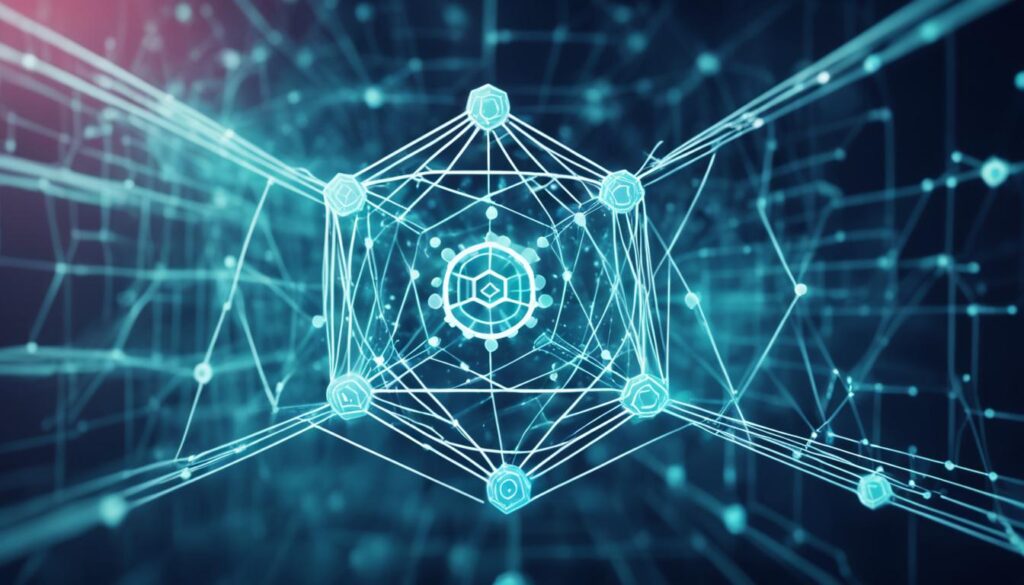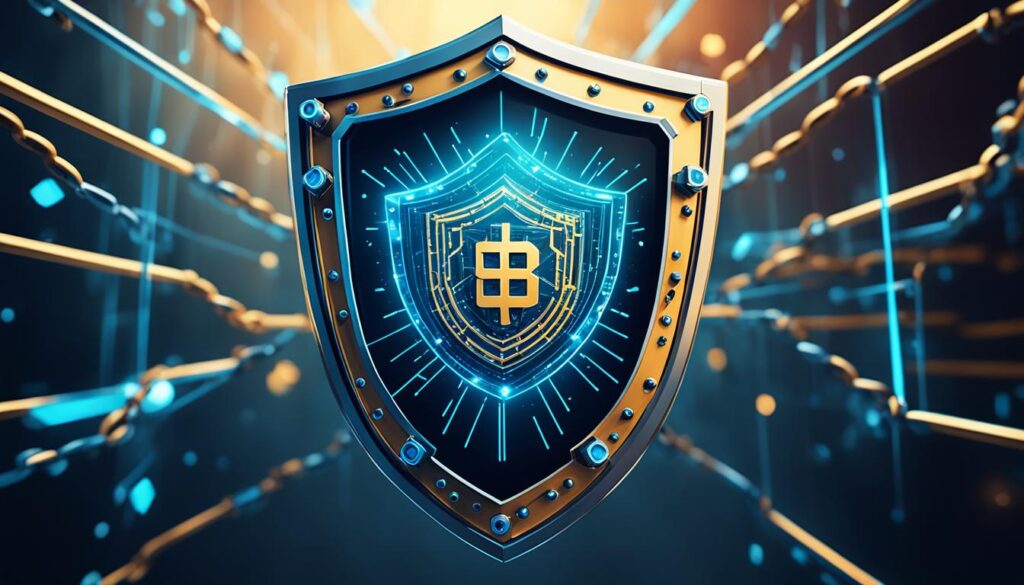Web 3.0, the latest evolution of the internet, is set to bring significant changes to the cybersecurity landscape and data privacy concerns. With its core principles of decentralization and openness, Web 3.0 aims to address the limitations and risks associated with Web 2.0. This new version of the internet relies on technologies like blockchain, adaptive AI, and decentralized applications to enhance security and protect user data.
Web 3.0 offers a digital transformation in cybersecurity by utilizing innovative solutions to counter internet security challenges. It enables a more secure and private online environment, with advancements in data protection and user control over personal information. However, it also introduces new security risks that organizations must be prepared to address.
Key Takeaways:
- Web 3.0 revolutionizes the internet by incorporating decentralization and openness.
- It addresses privacy concerns and security risks present in Web 2.0.
- Web 3.0 leverages blockchain, adaptive AI, and decentralized applications to enhance data protection and security.
- Organizations need to adapt and adopt new security measures to navigate the evolving digital landscape.
- Ensuring the integrity of source data and protecting personal information are crucial aspects of Web 3.0’s impact on cybersecurity and data privacy.
The Evolution of the Internet: Web 1.0, Web 2.0, and Web 3.0
The internet has undergone a remarkable evolution, transforming the way we access information, connect with others, and interact with digital content. Let’s delve into the three major stages of this evolution: Web 1.0, Web 2.0, and Web 3.0.
Web 1.0: The Read-Only Web
In the early days of the internet, Web 1.0 emerged as a predominantly read-only platform. Websites offered static content, allowing users to simply browse and access information. Interactivity and user-generated content were limited, with websites operating more like digital brochures or catalogs.
During this era, the primary focus was on providing information rather than user participation. Websites acted as one-way communication channels, serving as online repositories of knowledge.
Web 2.0: The Rise of User Participation
The advent of Web 2.0 brought a significant shift in internet dynamics. This phase marked the rise of user-generated content, transforming the internet into an interactive and collaborative platform. Users could contribute, share, and interact with content.
Web 2.0 marked a fundamental shift in the way the internet was perceived, empowering users to actively participate in the online world.
Social media platforms, blogs, online forums, and video-sharing websites became the driving forces of Web 2.0. The internet now thrived on user engagement, facilitating communication, collaboration, and knowledge-sharing among individuals worldwide.
Web 3.0: The Metaverse and Beyond
Web 3.0 represents the latest evolution of the internet, pushing the boundaries of interactivity even further. With the integration of artificial intelligence, machine learning, and interactive 3D graphics, Web 3.0 is often referred to as the metaverse.

In the metaverse, users can access services, share ideas, and interact with content in immersive and dynamic environments. This evolution promises to revolutionize various industries, including gaming, entertainment, education, and e-commerce.
Web 3.0 harnesses advanced technologies to create intelligent, personalized, and contextually aware digital experiences. It opens up possibilities for virtual reality, augmented reality, smart devices, and internet-connected sensors, transforming the way we live, work, and communicate.
| Web Version | Main Features |
|---|---|
| Web 1.0 | Read-only web with static content |
| Web 2.0 | User-generated content and interactivity |
| Web 3.0 | Integration of AI, machine learning, and immersive experiences |
As we explore the evolution of the internet from Web 1.0 to Web 2.0 and now to Web 3.0, it becomes evident that each phase has reshaped the digital landscape and redefined our online experiences. The internet continues to evolve, and we can only anticipate further advancements as we embrace the potential of Web 3.0 and the metaverse.
The Security Impact of Web 3.0’s Decentralization
Web 3.0’s decentralization presents both opportunities and challenges when it comes to security. By distributing data and eliminating single points of attack, the decentralization of Web 3.0 benefits users. However, it also expands the attack surface and introduces difficulties in enforcing content regulations.
One critical consideration in the decentralized web is trusting source data. Corrupt data can lead to various security vulnerabilities, making data integrity a top priority. This is where adaptive AI and blockchain technology come into play. Adaptive AI systems can analyze and validate data, ensuring its credibility and mitigating the risks of data corruption.
Blockchain technology, with its transparent and immutable nature, plays a crucial role in guaranteeing data integrity and rationalizing large data sets. By leveraging blockchain, Web 3.0 provides a secure environment for data storage and transactions.
The complexity of Web 3.0 introduces new cybersecurity risks that organizations must address. Smart contract logic hacks and the redefinition of trust boundaries pose significant challenges. Organizations need to adopt new security measures and develop a comprehensive strategy to combat these emerging threats.
“Web 3.0’s decentralization presents both opportunities and challenges in terms of security.”
To navigate the security landscape of Web 3.0 successfully, organizations must prioritize data integrity, implement robust security measures, and stay informed about emerging cybersecurity risks. By doing so, they can embrace the potential of Web 3.0 while safeguarding their digital assets and maintaining the trust of their users.
The Security Impact of Web 3.0’s Decentralization:
| Cybersecurity Risks | Trust Challenges | Data Integrity |
|---|---|---|
| Expanded attack surface | Difficulties in enforcing content regulations | Preventing data corruption |
| New cybersecurity threats | Redefinition of trust boundaries | Utilizing adaptive AI and blockchain technology |
| Smart contract logic hacks |
By addressing these challenges and embracing the security measures of Web 3.0, organizations can harness the benefits of decentralization while protecting their data and ensuring a secure digital future.

Privacy Concerns in Web 3.0 and the Metaverse
Web 3.0 and the metaverse have raised significant privacy concerns in the digital age. With the advancements and innovations brought by Web 3.0, the collection and utilization of personal data have reached unprecedented levels, surpassing the practices of previous internet versions.
Companies now have the ability to track not only traditional online activities but also intimate and real-time biometric data. This heightened level of surveillance raises potential privacy violations and calls for a closer examination of data protection measures.
User behavior monitoring poses another significant challenge when it comes to privacy. The personalized advertising campaigns driven by Web 3.0’s advanced technologies require extensive user data analysis. However, this raises concerns about the ethical use of personal information and the potential manipulation of user behavior to achieve marketing goals.
“Web 3.0 and the metaverse have brought forth new possibilities for businesses and individuals, but they have also given rise to complex questions regarding privacy. As we embrace the benefits of these technologies, we must find a balance between personalization and protection.”
Moreover, the decentralization aspect of Web 3.0 raises questions about who will enforce regulations for hosted content and how online harassment, hate speech, and inappropriate content will be addressed. The absence of a centralized authority in this new paradigm further complicates the management of privacy concerns and necessitates innovative solutions.
The challenge of maintaining privacy in the age of Web 3.0 is a critical one. As individuals and organizations navigate this new digital landscape, it is crucial to prioritize privacy protections, establish clear guidelines for data collection and usage, and foster a culture of responsible data handling.
Image:

The Role of Blockchain in Web 3.0 Security
Blockchain technology plays a vital role in ensuring the security of Web 3.0, providing a robust foundation for data protection and integrity. The implementation of distributed ledger technology (DLT) eliminates the need for intermediaries and central databases, creating a more secure environment for data storage and transactions.
DLT stores information in blocks, linking them in a chain that ensures immutability. This makes it incredibly difficult for unauthorized parties to alter or delete data, enhancing the overall security of the system. By leveraging blockchain, Web 3.0 offers a higher level of security compared to previous iterations of the internet.
User-driven access and blockchain deployments further enhance data protection and integrity. With blockchain, users have control over their data and can selectively share it with trusted entities, reducing the risk of unauthorized access. Additionally, the transparent nature of blockchain ensures that any modifications or tampering attempts are easily detectable, providing an additional layer of security.
Blockchain technology also enables secure cross-border transfers, supply chains, and electronic payments in Web 3.0. The decentralized nature of blockchain removes the dependency on centralized authorities and intermediaries, reducing the risk of single points of failure and data breaches. This paves the way for secure and efficient transactions, minimizing the potential for fraud or manipulation.
Overall, the role of blockchain in Web 3.0 security cannot be overstated. Its decentralized and immutable nature, combined with user-driven access and enhanced data protection mechanisms, make it a critical component in mitigating security risks and ensuring the integrity of the digital ecosystem.

| Benefits of Blockchain in Web 3.0 Security | Challenges of Blockchain in Web 3.0 Security |
|---|---|
| 1. Increased data protection and integrity | 1. Scalability concerns due to the distributed nature of blockchain |
| 2. User-driven access control | 2. Regulatory and compliance challenges |
| 3. Enhanced transaction security | 3. Energy consumption and environmental impact |
| 4. Reduction of single points of failure | 4. Public vs. private blockchain considerations |
Table: Benefits and Challenges of Blockchain in Web 3.0 Security
Conclusion
Web 3.0 is an exciting and transformative evolution of the internet, bringing forth advancements in technology and user experiences. However, with these advancements come new challenges and risks in the realm of cybersecurity and data privacy.
Web 3.0’s decentralization, integration of artificial intelligence, and the metaverse require organizations to adapt and adopt new security measures to protect personal data and ensure the integrity of source data. As the digital landscape continues to evolve, it becomes crucial to strike a balance between innovation and safeguarding user privacy and security.
Addressing privacy concerns and implementing strong cybersecurity practices are vital to create a more secure digital future for individuals and organizations alike. By leveraging the benefits of Web 3.0 while being vigilant about potential risks, we can navigate this evolving landscape and build a safer online environment for everyone.
FAQ
What is Web 3.0?
Web 3.0 represents the next significant evolution of the internet, where all web data is machine-readable and interconnected. It is built on the core concepts of decentralization, openness, and greater user utility, requiring the adoption of blockchain, adaptive AI, and decentralized applications.
How does Web 3.0 differ from Web 1.0 and Web 2.0?
Web 1.0 was a read-only web where users could only access information on websites. Web 2.0 introduced the concept of user-generated content, allowing users to interact and contribute to websites and applications. Web 3.0, the latest iteration, takes interactivity to a whole new level with the integration of artificial intelligence, machine learning, and interactive 3D graphics.
What are the security risks associated with Web 3.0’s decentralization?
Web 3.0’s decentralization creates opportunities and challenges in terms of security. Trusting source data becomes critical, as corrupt data can lead to security vulnerabilities. The complexity of Web 3.0 introduces new cybersecurity risks, such as smart contract logic hacks and the redefinition of trust boundaries.
What are the privacy concerns in Web 3.0 and the metaverse?
Web 3.0 and the metaverse raise privacy concerns as personal data collection and usage become more extensive. User behavior monitoring for personalized advertising campaigns poses challenges in terms of privacy. Questions arise regarding who will enforce regulations for hosted content and how inappropriate content will be handled in a decentralized web.
How does blockchain ensure security in Web 3.0?
Blockchain technology plays a vital role in ensuring security in Web 3.0. The implementation of distributed ledger technology (DLT) eliminates intermediaries and central databases, providing a more secure environment for data storage and transactions. DLT stores information in blocks and ensures immutability, making it difficult to alter or delete data.
What is the impact of Web 3.0 on cybersecurity and data privacy?
Web 3.0 revolutionizes the internet and reshapes cybersecurity and data privacy practices. While it brings advancements and opportunities, it also introduces new challenges and risks. Protecting personal data, addressing privacy concerns, and ensuring the integrity of source data are crucial aspects in the journey towards a more secure digital future.








